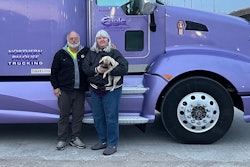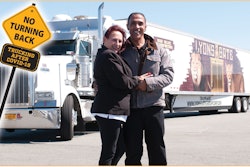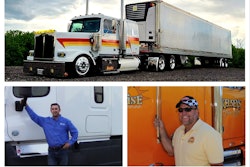History is rich with companies that worked tirelessly to save their sinking ship rather than change when the need became inevitable. Business models within trucking aren't immune to these shifting sands.
Ongoing legal battles around California’s A.B. 5 contractor law seem to be only the first of winds that could blow a lot of owner-operators in new directions. Witness the PRO Act passing the House, setting the stage for the independent contractor measures to remain even more a fixture of conversation at the national level (even if it doesn’t pass muster in the closely divided Senate, which seems unlikely).
This is just one example of threatening changes to the norms we’ve been accustomed to. They can’t be ignored, but they also can’t be the only consideration for decisions we make as business owners. If you’ve been thinking about taking your business to the next level by obtaining carrier authority, you’re hardly the only one.
My Overdrive colleague Todd Dills and Overdrive sister publication CCJ have highlighted the large influx of new entrants – or carriers who’ve applied for and received operating authority within a year and a half. By the end of 2020, 76,719 one-truck businesses were thus classified. Historically, that’s a very big number compared to earlier times. Though these are not all Class 8 tractor-trailer owner-operators, it’s a clear indication that demand for such businesses is on the rise.

Operating with authority comes with added costs, for sure. But what one person sees as a barrier another will see as a door opening. When trucking businesses have been as profitable as the records show us from 2018 through 2020 -- even with the short periods of rate recession – potential owners can come under the sway of the “fear of missing out.”
Newly released information from financial services provider ATBS supports the perception of improved income for independents. As Overdrive Editorial Director Max Heine reported, “average net income in 2020 for leased and independent operators combined jumped from almost $63,000 in 2019 to $67,742 in 2020, thanks to pandemic-related economic changes.”
What has changed in the last 18-24 months for new-authority owners in particular? Relatively increased ease in finding freight and getting paid faster.
The new owners I’ve visited with in the last 12 months stress this has been the difference-maker, with quicker payments built into the online load boards and brokerage platforms, whether through quick-pay schemes or partnered factoring arrangements. They tell me these service companies have improved their services greatly, and even when prices are posted they have been able to negotiate better rates than originally listed many times. That’s likely because of the capacity shortages and turmoil in the markets, so I wouldn’t bank on that forever. But it does look like competition has been pushing the service providers to institute improvements.
Time will tell how many of these companies and tech platforms are still emerging. But remember there are subscription costs for many load-board services. Make sure what you’re spending is justified by the freight you’re putting on the hook. (Never forget bedrock basics of business in the rush to expand or change.)
When is the right time to upgrade and go out on your own at an authorized carrier? Or better yet – start a trucking business generally?
There is no crystal ball, and there is uncertainty every day when you own a business. So here's the short answer: When you’re ready to accept the risk of failure.
Many entrepreneurs I’ve known have shared stories of bankruptcies and other major setbacks. Survival, and eventual success, often takes years of steady commitment, as well as acceptance that the person you see in the mirror is the person responsible.
Doing your homework could take three to six months or more, and this is your first test of business ownership readiness. Here’s a short list of things you may want to invest in:
- Hiring the tax accountant and choosing a business structure
- Developing a bookkeeping system
- Payroll plans
- Knowing how to get all the required tax ID numbers, permits, licenses
- Understanding how to apply for authority – and what’s required (and what’s most usually advisable) from an insurance perspective
- Managing IFTA and the IRP apportionment systems
- Compliance management requirements like your hours of service, driver qualification file and drug-testing consortium
- Knowing where you will get your loads to haul -- who'll be your customer?
- How you’ll be paid, and when
- A close handle on the cost of owning the business, plus the cost of driving the truck (your driver pay)
Do you have sufficient savings for personal needs, plus operating capital to cover your expenses through the transition? How much will you need to cover benefits such as health insurance, retirement deposits and vacation time?
The hardest thing for a new owner to predict is operating costs. So take advantage of the benchmark information from companies like ATBS and the freight rate information from DAT and Truckstop.com, for example. Remember, this is historical data, but still useful in planning.
If you don’t own a truck, well … that purchase may be your toughest decision yet.
Just as it’s advisable to have a robust plan for entry, have an exit plan, too, as I've written. That story followed my own retirement and the sale of my truck, but it could also be an entirely different discussion – about what happens when a person reverses course, and the financial fallout that follows.
A final thought: I've learned that we tend to overestimate the positive. That includes overestimating the income we will make or the days we can work. We always seem to underestimate costs. To help avoid this, find yourself an accountability partner. That person should be someone who isn’t afraid to do what you ought to yourself: Question everything.
You can find more information about taxes, truck purchasing, going independent with your own authority, and more in the updated 2021 edition of the Overdrive’s Partners in Business manual for owner-operators and prospective owner-ops, sponsored by TBS Factoring Service and available for download via the link.











